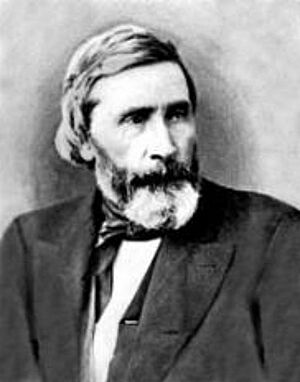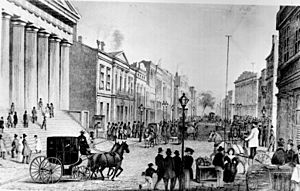James P. Kirkwood facts for kids
James Pugh Kirkwood (born March 27, 1807 – died April 22, 1877) was an important American civil engineer in the 1800s. He helped build many early railroads. Kirkwood was the main boss, called general superintendent, of the Erie Railroad from 1849 to 1850. After that, he went west to build more railroads. He even made the first plans for the Missouri Pacific Railroad, which stretched from the Mississippi River to the Rocky Mountains. Two towns, Kirkwood, Missouri and Kirkwood, New York, are named after him. He was also the president of the American Society of Civil Engineers in the late 1860s.
Contents
James Kirkwood's Life Story
Kirkwood was born in Edinburgh, Scotland. He went to Edinburgh College and learned about civil engineering. He got his start working on the Boston and Albany Railroad. Many engineers from this project later worked on the Erie Railroad.
In 1832, Kirkwood came to the United States. He started working on the Norwich Worcester Railroad. He also worked on the Boston & Providence Railroad. In 1835, he became an Assistant Engineer for the Stonington Railroad. That same year, he planned the route for the Long Island Rail Road. This railroad opened in 1837. He was in charge of building it until a money crisis, called the panic of 1837, stopped the work.
In 1840, Kirkwood became a Resident Engineer for the Western Rail Road. He stayed there until it was finished in 1843. He also planned and built the Springfield & Northampton Rail Road. In 1848, he finished building the Starrucca Viaduct in just one year. This viaduct was near Lanesboro, Pennsylvania. It was known as the most expensive railroad bridge of its time. It was also the largest stone viaduct built then. This project was one of the first to use concrete in American bridge building. Because of this success, he became the General Superintendent of the Erie Railroad on April 1, 1849. He took over from Hezekiah C. Seymour.
Just one year later, on May 1, 1850, Charles Minot took over Kirkwood's job at the Erie Railroad. Kirkwood then became the Chief Engineer of the Missouri Pacific Railroad. He was in charge of building the railroad from St. Louis to Pacific, Missouri. The towns of Kirkwood, Missouri and Kirkwood, New York are named after him. In the late 1860s, he helped finish the Bergen Tunnel. At that time, he was also the Engineer for the Brooklyn Water Supply. His hard work helped make this project a success.
In 1865, he became the Chief Engineer of St. Louis, Missouri. His job was to design a modern water system for the city. He worked there until 1867. After that, he moved back to New York. From 1867 to 1868, he was the president of the American Society of Civil Engineers. In his last years, he worked as a consulting engineer for the water-works in Lynn, Massachusetts.
Kirkwood passed away in Brooklyn, New York, in 1877. He was 70 years old. He was buried in Green-Wood Cemetery.
Kirkwood's Important Projects
The Starrucca Viaduct
The Starrucca Viaduct was designed by Julius W. Adams and James P. Kirkwood. It was built between 1847 and 1848 by the New York and Erie Railroad. The viaduct was made from bluestone found nearby. It also used concrete in its base and deck. This might have been the first time concrete was used structurally in an American bridge.
The viaduct was built to solve a big engineering problem. The Starrucca Creek valley was very wide. The railroad first thought about building a large dirt mound, called an embankment. But they realized it would be too hard to do. The Erie Railroad had a lot of money from British investors. Even with money, most American builders at the time couldn't handle such a huge task.
Julius W. Adams was the main engineer overseeing construction in that area. He hired James P. Kirkwood, who had worked on the Long Island Rail Road. It's not fully clear if Kirkwood designed the bridge himself or worked under Adams. About 800 workers built the bridge in one year. Each worker was paid about $1 per day. The wooden supports needed to build the bridge used more than half a million feet of timber.
Leading the Erie Railroad
The first general superintendent of the Erie Railroad was Hezekiah C. Seymour. In 1849, he planned to leave his job. A new superintendent needed to be chosen. S. S. Post was in charge of transportation. Many employees liked him and hoped he would get the job.
James P. Kirkwood was also considered for the position. Some people were so sure Post would be chosen that they prepared a sign saying "S. S. Post, General Superintendent." But the news came that the company's leaders chose Kirkwood. This disappointed many of the workers. This happened in April 1849.
Superintendent Kirkwood became known as the "Silent Man" among railroad workers. This was because of his quiet nature. His office was at 56 Wall Street in New York. It was easy to meet with him. When someone came in, Kirkwood would look up for a moment. If the visitor didn't immediately say why they were there, Kirkwood would go back to his work without a word. The visitor might stand or sit there all day. Kirkwood would not pay attention until the visitor spoke up and explained their reason for visiting.
See also
- Compton Hill Reservoir Park
- Long Dock Tunnel
Selected Publications
- James Pugh Kirkwood (1867) Brooklyn Water Works and Sewers: A Descriptive Memoir
- James Pugh Kirkwood, Saint Louis (Mo.). Board of Water Commissioners (1869) Report on the filtration of river waters: for the supply of cities, as practised in Europe, made to the Board of water commissioners of the city of St. Louis. D. Van Nostrand.




